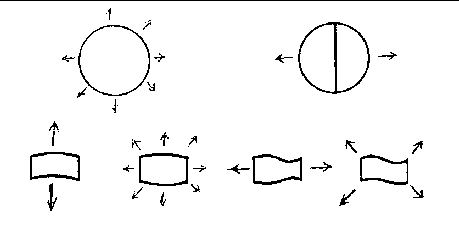Modes of Vibration and Directivity of Percussion Instruments
Thomas D. Rossing
Physics Department
Northern Illinois University
DeKalb, IL 60115
Popular version of paper 3aAA2 presented at the 131st ASA Meeting in Indianapolis, IN
Veteran concert-goers, as well as performing musicians, know that no two persons in a concert hall hear the same concert. This is partly due to the acoustical features of the concert hall, of course, but it is also due to the fact that musical instruments radiate different sounds in different directions. This is especially true of instruments in the percussion family in which the vibrating membranes, plates, or bars radiate most of their sound directly with little or no assistance of sounding boards or resonators.
Consider a vibrating drumhead, for example. When the membrane is struck, many different modes or patterns of vibrations are excited, including the six important ones shown in Fig. 1. Each of these modes of vibration has its own pattern of radiation. The first one radiates pretty much in all directions, at least in its own plane, but the other four radiate most strongly in 2, 4, 6, or 8 directions, respectively. They generate sound fields which are said to exhibit monopole, dipole, quadrupole, hexapole, and octupole character.

Fig. 1 Five modes of vibration of drumhead. Arrows indicate the directions of maximum sound radiation in the plane of the membrane.
Outdoors, or well away from sound reflecting surfaces, the radiation patterns from these different modes of vibration would be quite discernable by the listener. In a kettledrum or timpani, for example, the 2nd mode in Fig 1 radiates the fundamental note, while the overtones radiated by the 3rd, 4th, and 5th modes are a musical 5th, an octave, and a 10th higher (if the fundamental is C, the overtones would be G,C, and E, respectively). It is obvious that listeners at different locations would hear quite a different timbre or tone quality due to the directionality of these different radiations. Inside a concert hall, or course, reflections from the walls, ceiling, floor, and other surfaces mix the sounds together, and the directionality of the timbre is not nearly so apparent to the listener. Subtle, and often surprising, differences do exist, however, and they do effect the quality of the performance. This it is very important to understand them.
In a two-headed drum, such as a snare drum, the directional radiation patterns from the two vibrating membranes interact, and the directionality of the sound becomes even more complex. In fact, the two membranes interact strongly as they vibrate, and so the modes or patterns of the drum are quite different form what they are in a drum with a single membrane. Four modes of vibration of a snare drum, in which the heads vibrate in much the same way as they do in the first two modes in Fig. 1, are shown in Fig. 2. The directions in which maximum sound is radiated are indicated by arrows.

Fig. 2 Four modes of vibration of a two-headed snare drum. The heads vibrate in much the same patterns as the first two modes in Fig. 1. Directions of maximum radiation for each mode are shown by the arrows.
Bells have particularly complicated radiation patterns because of their many modes of vibration and also because of their rather complex shapes. For example, the volume of the air enclosed by the bell changes twice during each cycle of a vibration, so that along the axis of the bell, the listener hears rather strong overtones having twice the frequency of the direct radiation. This effect is particularly noticeable in handbells, which radiate a strong octave partial entirely by this mechanism.
Caribbean steel pans also have very complicated radiation patterns, sine sound is radiated not only by vibrations of the note area that is struck by the mallet, but also by other note areas and by other surfaces of the drum as well.
Mallet percussion instruments, such as marimbas, xylophones, and vibraphones (“vibes”) have radiation patterns that are influenced by the tubular resonators placed below the vibrating bars. The sound patterns are affected by the neighboring resonators as well as the resonator directly below the bar.
References:
N.H. Fletcher and T.D. Rossing, The Physics of Musical Instruments (Springer-Verlag, New York, 1991) T.D. Rossing, “Acoustics of Drums,” Physics Today (March 1992), p.40-47.
